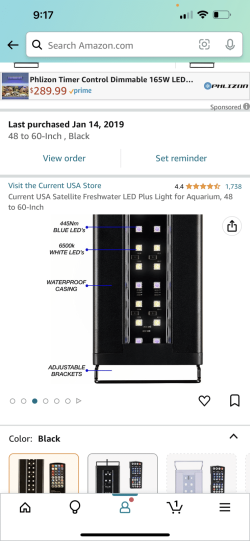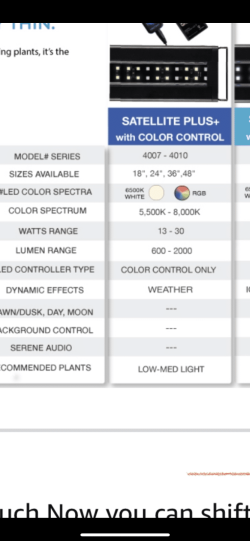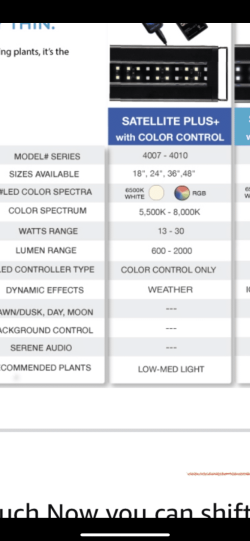I just have one silver dollar left. It’s 14 years old. I also have loaches and Congo tetras.How many dollars do you have and do you have any other plant eaters?
I'd be tempted to try something as weed like as Hornwort weighted down. If that works you could maybe try some other fast growing stems like Anacharis or Limnophilla Sessiflora but there is a chance they dont last a night haha! I had really good luck with Hygrophilla Siamensis 53b with a Severum and a load of Annostomus (plant eaters) once but couldnt replicate it again.
Wills
You are using an out of date browser. It may not display this or other websites correctly.
You should upgrade or use an alternative browser.
You should upgrade or use an alternative browser.
Plants to Outcompete Algae
- Thread starter FranM
- Start date
I have dropped the lighting time to six hours a day. I have to try to find the type of lightYou're in a bit of a pickle hereordinarily we'd be recommending more water changes and more plants! Tricky one to solve
would dropping your light intensity work?
i bet if you got 100 of the long root plants it would work.So you’re saying the entire surface needs to be covered? How about 100 floating plants? There’s no way I’m going to allow the entire surface to be covered. 50 plants to start? Is there any way to really know?
they also divide so fast it's not hard to cover the surface.
my example was with duckweed, which has tiny roots
i bet if you got 100 of the long root plants it would work.
they also divide so fast it's not hard to cover the surface.
my example was with duckweed, which has tiny roots
Attachments
Very nice but this is no help. You have a planted tank with some fish. I have fish first. I have fish that destroy plants.It took 6-8 weeks for my tank to get from a single pot of Amazon Frogbit to this.

At weekends when I do water changes I just scoop out the surplus and bin it.
The Amazon frogbit is the stuff that is floating on the top. In spring I started dumping the surplus in my fishpond and it is growing faster in there than the Koi can destroy it.Very nice but this is no help. You have a planted tank with some fish. I have fish first. I have fish that destroy plants.
None of us can advise as to how many floating plants you need or should have. There has been no species mentioned. In a tank with a surface area of 4 feet by 4 feet that is 16 square feet of surface. To be effective you want floating plants that are what I term substantial, as opposed to tiny things. Duckweed, salvinia etc are the latter. Water Sprite, Water Lettuce and Frogbit are the former. Some stem plants will grow well left floating. As for numbers, I would get a few of whichever of the three mentioned species you like or can get, maybe five or six of whichever species. Assuming all is well, they will settle in and then grow and multiply. I bought one Water Sprite in the late 1990's and I had it in every tank in my fishroom and regularly thinned it out as it grew, depending upon the effect I wanted. I bought two Frogbit plants, that looked like they were at death's door, but they settled in and covered my 70g tank surface in a few months, and they too were regularly thinned out.
seannx
New Member
What is your light source? Algae can be easily controlled with a lamp that allows you to adjust white, blue, green and red light levels. Keeping the blue light very low was the key for my tank. No diatoms at all, and I never have to clean the glass from green algae, as a couple of nerite snails take care of that. Diatoms also thrive with high nitrate levels, so make sure you aren’t over feeding.
What is your light source? Algae can be easily controlled with a lamp that allows you to adjust white, blue, green and red light levels. Keeping the blue light very low was the key for my tank. No diatoms at all, and I never have to clean the glass from green algae, as a couple of nerite snails take care of that. Diatoms also thrive with high nitrate levels, so make sure you aren’t over feeding.
These are the specifics of the light fixture I have. Do you consider low or medium light?
Attachments
I have one remaining silver dollar of 14 years. I also have four clown loaches which range from an inch to six inches. I have two yo-yos that are approx 4-5 inches and a dozen adult Congo tetras all in a 120 gallon. I have two Fluval 407’s filtering. Does this shed some light? I have phosphate in tap. I can go close to two weeks before needing a water change. Nitrate would be approx 25 ppm.None of us can advise as to how many floating plants you need or should have. There has been no species mentioned. In a tank with a surface area of 4 feet by 4 feet that is 16 square feet of surface. To be effective you want floating plants that are what I term substantial, as opposed to tiny things. Duckweed, salvinia etc are the latter. Water Sprite, Water Lettuce and Frogbit are the former. Some stem plants will grow well left floating. As for numbers, I would get a few of whichever of the three mentioned species you like or can get, maybe five or six of whichever species. Assuming all is well, they will settle in and then grow and multiply. I bought one Water Sprite in the late 1990's and I had it in every tank in my fishroom and regularly thinned it out as it grew, depending upon the effect I wanted. I bought two Frogbit plants, that looked like they were at death's door, but they settled in and covered my 70g tank surface in a few months, and they too were regularly thinned out.
I have one remaining silver dollar of 14 years. I also have four clown loaches which range from an inch to six inches. I have two yo-yos that are approx 4-5 inches and a dozen adult Congo tetras all in a 120 gallon. I have two Fluval 407’s filtering. Does this shed some light? I have phosphate in tap. I can go close to two weeks before needing a water change. Nitrate would be approx 25 ppm.
When I mentioned species I was referring to the floating plant species. You askd how many floating plants, and it depends upon which species of floating plants, as I think I explained previously. So you would not want 100 of Water Sprite, only a couple.
Fish species OK, but the nitrate is worrying, and could be related to water changes being insufficient. Taking the latter first, most of us here do and recommend once a week changes, and at least 50%, I do 60-70%. I have an article on water changes that may give you the reasoning,

Regular Partial Water Changes
Byron Hosking November, 2010 (rev April 2021) Nothing is more important when it comes to aquarium maintenance than regular partial water changes. The adage “an ounce of prevention is worth a pound of cure” certainly applies here. One frequently reads of products that will reduce the need for...
 www.fishforums.net
www.fishforums.net
Nitrates at 25ppm is higher than we should aim for. Have you tested the source (tap) water for nitrate? If it has nitrates, that is one issue depending what they are, but if zero that is easier to deal with because it means the nitrates are being produced by the biological system, and there are ways to lower these. Floating plants will make a big impact here, not by using nitrate but by taking up all the ammonia that would ever be produced, all else being equal. Plants prefer ammonia/ammonium as their source of nitrogen, and they, especially fast growers, are faster at taking up ammonia/ammonium than the nitrifying bacteria/archaea , and with plants they do not produce nitrite, and thus no nitrate resulting.
Getting the nitrate as close to Zero is the goal, and then making sure it stays close until the next water change. Causes of nitrates being high are overstocking, overfeeding, insufficient water changes along with substrate and filter cleanings. And live plants help as mentioned. I did sporadic tests on my fishroom of tanks over a decade, and the nitrates always tested in the 0 to 5 ppm range, which was the lowest on the API test; could have been 0, or 1, or 2, etc, but clearly never over 5 and that was about as good as it gets. My plants and water changes were clearly why this stability remained.
I'll respond on the light question with another post.
On the light issue. Aquatic plants do best in white light that is composed of especially red, blue and green in the spectrum. Red and blue drive photosynthesis, of which red is the most important. Green added to this does improve the plants' response. We can express this using the Kelvin scale, which is included in the light data in post #25. A lower K means the white light is composed of less red and more blue, and the higher the K the more blue and less red. We think of this as warm light (higher red) and cool light (more blue). A Kelvin in the range of 5000K to 6500K is ideal, and very close to the sun under which plants evolved. Marine tanks need much higher blue, to grow corals for example, so white light in the 9000K to 12000K range is best. But in a freshwater tank, this would not help plants and it will promote algae problems. So aim for light in the 5000K-6500K range. This also produces a truer colour rendition.
I don't have much luck with frogbit. I think my salvinia minima outcompetes it.It took 6-8 weeks for my tank to get from a single pot of Amazon Frogbit to this.

At weekends when I do water changes I just scoop out the surplus and bin it.
I used to do weekly water changes. Bu
As far as plant species go I was looking at floating plants that are nitrate suckers—duckweed. Water lettuce. Frogbit. But I don’t think five of each is going to make a dent. This is my point. I have a photo somewhere of the light fixture I have. Going to add it here. Please give me your opinion.


I used to do weekly water changes but when my schedule changed they went to ten days. I do water changes when the nitrate hits 20-25. I don’t have nitrate in my tap, just phosphate.When I mentioned species I was referring to the floating plant species. You askd how many floating plants, and it depends upon which species of floating plants, as I think I explained previously. So you would not want 100 of Water Sprite, only a couple.
Fish species OK, but the nitrate is worrying, and could be related to water changes being insufficient. Taking the latter first, most of us here do and recommend once a week changes, and at least 50%, I do 60-70%. I have an article on water changes that may give you the reasoning,

Regular Partial Water Changes
Byron Hosking November, 2010 (rev April 2021) Nothing is more important when it comes to aquarium maintenance than regular partial water changes. The adage “an ounce of prevention is worth a pound of cure” certainly applies here. One frequently reads of products that will reduce the need for...www.fishforums.net
Nitrates at 25ppm is higher than we should aim for. Have you tested the source (tap) water for nitrate? If it has nitrates, that is one issue depending what they are, but if zero that is easier to deal with because it means the nitrates are being produced by the biological system, and there are ways to lower these. Floating plants will make a big impact here, not by using nitrate but by taking up all the ammonia that would ever be produced, all else being equal. Plants prefer ammonia/ammonium as their source of nitrogen, and they, especially fast growers, are faster at taking up ammonia/ammonium than the nitrifying bacteria/archaea , and with plants they do not produce nitrite, and thus no nitrate resulting.
Getting the nitrate as close to Zero is the goal, and then making sure it stays close until the next water change. Causes of nitrates being high are overstocking, overfeeding, insufficient water changes along with substrate and filter cleanings. And live plants help as mentioned. I did sporadic tests on my fishroom of tanks over a decade, and the nitrates always tested in the 0 to 5 ppm range, which was the lowest on the API test; could have been 0, or 1, or 2, etc, but clearly never over 5 and that was about as good as it gets. My plants and water changes were clearly why this stability remained.
I'll respond on the light question with another post.
As far as plant species go I was looking at floating plants that are nitrate suckers—duckweed. Water lettuce. Frogbit. But I don’t think five of each is going to make a dent. This is my point. I have a photo somewhere of the light fixture I have. Going to add it here. Please give me your opinion.


Similar threads
- Replies
- 2
- Views
- 362
- Replies
- 1
- Views
- 166




